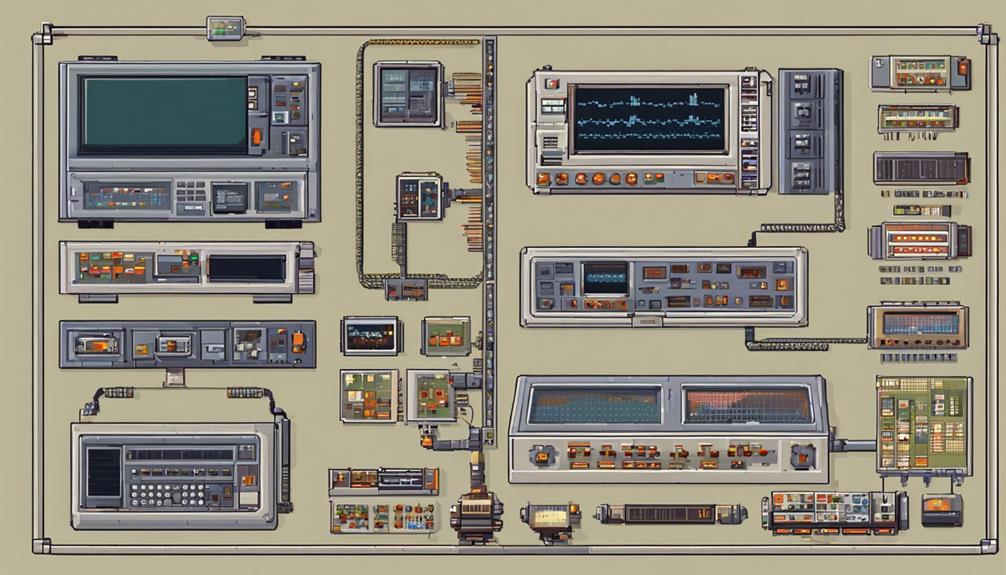Ground station equipment and hardware form the backbone of communication infrastructure between Earth and satellites. From sophisticated tracking antennas to RF receiver recorders, each component plays a pivotal role in establishing seamless connectivity. The integration of cutting-edge technology such as autotracking antennas and high gain RF links ensures robust communication channels. Moreover, the deployment of real-time telemetry software like JDA VuSoft enhances data handling efficiency. The intricate interplay of these systems underscores the critical importance of ground station equipment in satellite communication.
Key Takeaways
- Ground station antennas enhance signal reception with high gain and tracking capabilities.
- Ground station amplifiers boost signal power and maintain quality for reliable communication.
- Ground station receivers capture satellite signals across various frequency bands with high sensitivity.
- Signal processors in ground stations convert raw data into usable information for efficient analysis and communication.
Antennas for Ground Stations

Ground station antennas, utilizing parabolic dishes to concentrate signals from satellites, play a crucial role in facilitating effective communication with spacecraft. These antennas are fundamental components of Ground Station Hardware, enabling the establishment of bidirectional communication links with satellites. Antennas vary in size, with larger dishes offering higher gain, which enhances signal reception quality. The use of dual polarization antennas is common in ground stations to receive signals in different orientations, ensuring comprehensive coverage.
In the realm of Ground Station Hardware, antennas are indispensable for capturing signals from orbiting satellites and relaying commands or data back to them. Automatic tracking features integrated into antenna systems allow for precise synchronization with the movement of satellites, ensuring constant and reliable communication. This capability is particularly crucial for missions requiring real-time data transmission or remote control of spacecraft.
The design and placement of antennas in ground stations are meticulously planned to optimize signal reception and transmission efficiency. Factors such as antenna height, orientation, and interference mitigation are carefully considered to maintain a robust communication link with satellites. Overall, antennas serve as the backbone of ground station communication systems, enabling the seamless exchange of information between Earth-based stations and spacecraft in orbit.
Amplifiers in Ground Stations
Playing a pivotal role in signal enhancement and transmission integrity, amplifiers form essential components within ground station equipment for establishing robust communication links with satellites. Amplifiers in ground stations are crucial for ensuring that signals are boosted to adequate levels for reliable communication. Here are some key points regarding amplifiers in ground stations:
- Low noise amplifiers (LNAs) are commonly used in ground stations to amplify weak signals while maintaining a low noise figure. This is essential for ensuring that the amplified signal does not introduce additional noise that could degrade the overall signal quality.
- High power amplifiers (HPAs) are employed in ground stations to increase the power of signals before transmission to satellites. HPAs are essential for ensuring that the signals sent to satellites are strong enough to overcome any potential losses and interference.
- Amplifiers in ground stations play a critical role in overcoming signal losses over long distances and through various components. They help ensure that the signal remains strong and clear throughout the communication link.
- The selection of amplifiers in ground station equipment is crucial to ensure optimal signal quality and integrity during communication with satellites. Choosing the right amplifiers based on the specific requirements of the communication link is essential for achieving reliable and robust connections.
Receivers for Ground Stations

How are receivers designed to capture satellite signals for telemetry, tracking, and command purposes in ground station equipment? Ground station receivers are indispensable tools for acquiring satellite signals crucial for various operations. These receivers are meticulously crafted to operate efficiently across a broad frequency spectrum, typically spanning from L-Band to C-Band, ensuring compatibility with diverse satellite communication protocols. One key feature integrated into these receivers is the utilization of low noise amplifiers. These amplifiers are instrumental in boosting signal sensitivity while simultaneously diminishing the noise present in received signals, thereby enhancing overall signal quality.
Moreover, ground station receivers may incorporate cutting-edge digital direct conversion technology. This technology streamlines the signal processing and data extraction processes, facilitating swift and accurate decoding of incoming satellite data. By efficiently capturing and processing satellite signals, these receivers play a pivotal role in extracting valuable information for further analysis and communication within the ground station environment. In essence, the receivers in ground stations form the backbone of telemetry, tracking, and command operations, enabling seamless interaction with satellites and ensuring the smooth flow of critical data for mission-critical tasks.
Signal Processors in Ground Stations
Receivers for ground stations, crucial tools in capturing satellite signals for telemetry, tracking, and command purposes, rely on signal processors to convert raw satellite signals into usable data for analysis and communication. Signal processors in ground stations play a pivotal role in ensuring that the received signals are processed accurately and efficiently. Here are some key points about signal processors in ground stations:
- Signal processors perform essential functions such as demodulation, error correction, filtering, and data formatting to guarantee the accurate transmission of data.
- Advanced signal processors are designed to support various frequency bands and modulation techniques to cater to diverse satellite communication needs effectively.
- Real-time telemetry data processing is a critical function of signal processors, enabling efficient monitoring and control of satellite operations.
- The integration of signal processors with other ground station hardware components like antennas and transceivers is essential for enhancing overall communication reliability and performance.
Power Supply Units for Ground Stations

Power supply units for ground stations are essential components that ensure the continuous and reliable operation of critical equipment by providing uninterrupted power. These units play a vital role in maintaining communication links with satellites and spacecraft, making them a cornerstone of ground station infrastructure. Ground station power supplies are designed to handle varying loads and power requirements of different equipment components, ensuring seamless functionality even under high-demand situations. Additionally, to mitigate the risk of power outages, power supply units often incorporate backup generators and solar panels to guarantee uninterrupted operation.
| Features | Description | Importance |
|---|---|---|
| Redundancy | Integrated to prevent system failures during mission-critical operations | Ensures system reliability |
| Fail-safe Mechanisms | Included to enhance operational safety and prevent potential accidents | Critical for system security |
| Efficient Management | Essential for optimizing power distribution and ensuring effective utilization of available power resources | Maximizes operational efficiency |
Frequently Asked Questions
What Are Ground Equipment in Space?
Ground equipment in space, vital for satellite communication, includes antennas and transceivers that facilitate data transmission and reception techniques. These tools play a crucial role in tracking satellites and ensuring efficient communication with space assets. Advanced technology in these devices enables precise monitoring of satellite health and position from ground stations. The integration of these components forms a robust network for managing satellite missions effectively and maintaining seamless connectivity with space-based systems.
What Is the Difference Between a Ground Station and an Earth Station?
In the realm of satellite communication, the distinction between a ground station and an earth station lies in their primary functions. Ground stations are tailored for satellite telemetry, tracking, and command operations, ensuring efficient bidirectional communication with satellites. On the other hand, earth stations serve a broader spectrum of communication needs, handling terrestrial and satellite services like broadcasting and telecommunications. Both rely on advanced antenna technology to establish vital communication links with satellites in orbit.
How Does Ground Station Work?
A ground station operates by receiving signals from satellites through antennas and ensuring precise alignment for optimal data reception. Satellite tracking systems monitor and adjust antenna positions to maintain connectivity. Signals are processed by transceivers to convert them into usable data, which is then decoded and stored by data processing units. This seamless process enables efficient communication between ground stations and satellites in orbit, facilitating the exchange of information for various applications.
What Is Ground Station as a Service?
Ground Station as a Service (GSaaS) revolutionizes satellite communication by offering on-demand access to ground station coverage. This innovative solution caters to diverse mission needs, including data downlink, telemetry, tracking, and command operations. GSaaS eliminates the burden of establishing and managing dedicated ground station infrastructure, providing a scalable and cost-effective alternative. Satellite operators benefit from enhanced accessibility and tailored services, ensuring optimal performance for Earth observation, communication, and scientific research missions.
